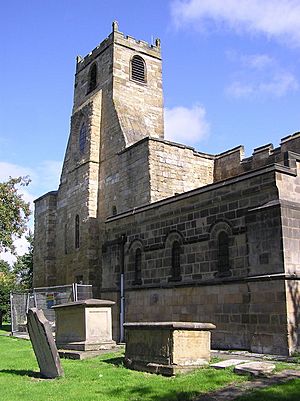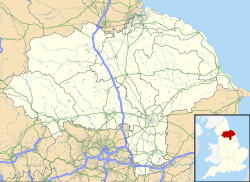St Mary Magdalene, Yarm facts for kids
Quick facts for kids Yarm Parish Church |
|
|---|---|
 |
|
| 54°30′36″N 1°21′29″W / 54.510°N 1.358°W | |
| OS grid reference | NZ 41633 12914 |
| Denomination | Church of England |
| Churchmanship | Broad Church/Liberal Catholic |
| History | |
| Dedication | St Mary Magdalene |
| Architecture | |
| Functional status | Active |
| Heritage designation | Grade II* |
| Administration | |
| Parish | Yarm |
| Deanery | Stokesley |
| Archdeaconry | Cleveland |
| Diocese | York |
| Province | York |
St Mary Magdalene Church is a special place of worship in the town of Yarm, North Yorkshire, England. It is part of the Church of England and is named after Mary Magdalene, a friend of Jesus. The current leader of the church is Reverend Darren Moore.
This church building is actually the third one to stand on this spot! The very first church was made of wood a long, long time ago, during the Anglo-Saxon period. Later, a stone church was built in the late 1100s, but it burned down in 1728. The church you see today was built in 1730, using some of the stones from the older building.
Church History
Early Churches: Anglo-Saxon and Norman Times
The oldest sign of a church here is a stone piece called the Trumbert Shaft. This is part of an old stone cross that was found in Yarm in 1877. It has ancient writing on it that says: "Pray for Trumberhet, Bishop. Alla set up this memorial to his brother."
Trumberhet was a bishop who lived around the year 681 AD. This means a church was likely in Yarm as early as the late 600s or early 700s!
Later, in the late 1100s, a stone church was built by a powerful family called the de Brus family. You can still see parts of this old stone church in the west end and the base of the tower of the building today. A strong, fortified tower was added in the 1200s and rebuilt in the 1600s.
The Georgian Church: Rebuilding After a Fire
In 1728, the old stone church was badly damaged by a fire. It cost a lot of money to fix it – about £1,772! People helped by donating money. Even King George II allowed churches all over England to collect money to help Yarm. This was very successful, and the church was rebuilt by 1730. They used many of the stones from the old building.
In 1878, the church was made bigger and improved by a famous building company called Paley and Austin. Over time, the stone of the Georgian part of the church has become worn out because of age and air pollution.
The Church Today
On June 23, 1966, St Mary Magdalene Church was given a special status as a Grade II* listed building. This means it's a very important historical building. The churchyard, which is the area around the church, is not used for new burials anymore. However, there is a special place for ashes after cremation.
The church is known for being welcoming and open-minded. It is part of the "broad church" and "liberal catholic" traditions within the Church of England. It is also a member of Inclusive Church, which means it welcomes everyone.
Inside the Church
Lady Chapel: A Quiet Place
The Lady Chapel is a special small area in the church. It was made new in memory of Leslie Leech. In 2003, the Archbishop of York, David Hope, officially dedicated it.
Beautiful Stained Glass Windows
The church has many beautiful stained glass windows that tell stories.
- The windows on the south side show stories from the Old Testament (the first part of the Bible). These include God testing Abraham, Moses receiving the Ten Commandments, and the prophet Elijah calling down fire.
- The large window showing Moses is the oldest and most impressive. It was made in 1768 by William Peckitt of York. It used to be in a different part of the church but was moved in 1879.
- The windows on the north side and at the east end of the church show stories from the New Testament (the second part of the Bible). These include Christ's Baptism, the Crucifixion, Christ the Lover of children, Christ the Good Shepherd, the Resurrection, the Last Supper, and the Ascension.
- At the west end of the church, there are two small round windows. One shows a dove, which represents the Holy Spirit. The other shows a Lamb carrying a flag, which represents Jesus Christ.
- In the Vestry (a room where the clergy get ready), there is a window from the 1900s. It shows the three Marys meeting an angel at the tomb on the first Easter Day.
Decorations and Symbols
Near the door to the vestry, there used to be an old painting of the Holy Family (Jesus, Mary, and Joseph) with a young John the Baptist. This painting was replaced in 2015 with a modern stained glass picture of Christ rising from the tomb.
On the left side of the Ascension window, there is an old copy of a Della Robia plaque. This type of artwork shows the Virgin and Child. It was found in the ruins of a French cathedral during the First World War by a writer named E. V. Lucas. Similar plaques can be found in old Italian monasteries. This one is from around 1800.
Around the church walls, you can see framed pictures called the Stations of the Cross. These show different moments from Jesus' last day. On the pillars, there are small shields with church symbols. In the Sanctuary (the area around the altar), there is a bishop's mitre (a special hat). This mitre reminds people that the Archbishop used to be the Rector (leader) of Yarm church until 1865.
Church Furniture
The pews (church benches), pulpit (where sermons are given), and choir stalls (where the choir sits) were all added in 1878. They are in a style called Renaissance style. The High Altar, which is the main table in the church, was made in 1940 from old pews.
The altar rails were made by a famous Yorkshire craftsman named Robert (Mousey) Thompson. He was known as the "Mouseman of Kilburn" because he carved a small mouse into all his work. These rails were given to the church in 1948 in memory of Mary Clapham and her son John Geoffrey, who died in the Second World War. You can find the dedication and the tiny mouse carved on the side of the rails facing the Sanctuary.
The Font, which is used for baptisms, is a large, eight-sided bowl made of Tees marble. It is thought to have been made in the 1400s.
The Organ
When the church was rebuilt in 1730, the organ was placed on a balcony at the west end. This is common in many churches. In Yarm, the organ balcony was removed in 1852, and the organ was moved to the east end of the north aisle. The current organ was bought in 1910. It has 1134 pipes and 27 different sounds!
The True Lovers' Tomb
Next to the west wall, set into the floor, is the cover of a very old tomb from the 1400s. It has carvings of a man and a woman lying down, a bird (like an eagle or falcon), and a seated figure giving a blessing. There's also writing that says it was used again in 1638. We don't know who the original important people buried here were, so they became known as The True Lovers. A path by the river nearby is even called "True Lovers' Walk."
Church Bells
The church has three bells.
- The oldest bell is from 1664 and weighs about 330 pounds. It says "Fili Dei Misere Mei" (Son of God, have mercy on me).
- The next oldest bell is from 1710 and weighs about 385 pounds. It says "Sono Quantum Valeo" (I sound as much as I am worth).
- The smallest bell weighs about 275 pounds. It was remade in 1861 because it had cracked. It has the names of the church leaders from that year, James Todd and Wheatley Coates.
Churchyard
In the churchyard, there is a modern headstone that remembers Tom Brown, who was known as "The Valiant Dragoon." He was a hero from a battle called the Battle of Dettingen. He died in 1746 and was buried in an unmarked grave. A short distance away, there is a stone marking where the Free Grammar School of Thomas Conyers used to be. This school was founded in 1590.
See also
- List of ecclesiastical works by Paley and Austin


